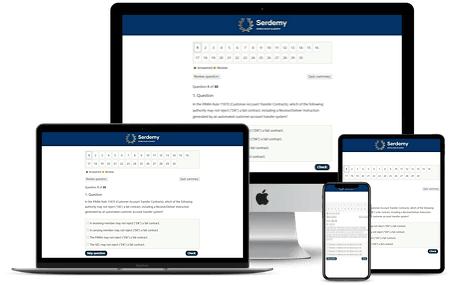Quiz-summary
0 of 30 questions completed
Questions:
- 1
- 2
- 3
- 4
- 5
- 6
- 7
- 8
- 9
- 10
- 11
- 12
- 13
- 14
- 15
- 16
- 17
- 18
- 19
- 20
- 21
- 22
- 23
- 24
- 25
- 26
- 27
- 28
- 29
- 30
Information
Premium Practice Questions
You have already completed the quiz before. Hence you can not start it again.
Quiz is loading...
You must sign in or sign up to start the quiz.
You have to finish following quiz, to start this quiz:
Results
0 of 30 questions answered correctly
Your time:
Time has elapsed
Categories
- Not categorized 0%
- 1
- 2
- 3
- 4
- 5
- 6
- 7
- 8
- 9
- 10
- 11
- 12
- 13
- 14
- 15
- 16
- 17
- 18
- 19
- 20
- 21
- 22
- 23
- 24
- 25
- 26
- 27
- 28
- 29
- 30
- Answered
- Review
-
Question 1 of 30
1. Question
Consider the actions of Anya, a compliance officer at a large custodian bank that services institutional clients. While reviewing transaction data, she observes that a major client, Momentum Asset Management, is rapidly accumulating a significant position in BioGenix Therapeutics, a mid-cap pharmaceutical company. This activity is inconsistent with Momentum’s usual strategies. Deducing that a potential takeover bid is imminent, Anya purchases a substantial number of out-of-the-money call options on BioGenix stock for her personal account before any public announcement is made. Based on the misappropriation theory of insider trading, which statement best describes the regulatory implications of Anya’s trading activity?
Correct
Anya’s actions constitute a violation of insider trading regulations under the misappropriation theory. This theory extends the liability for insider trading beyond traditional corporate insiders, such as officers and directors, to any person who trades on material nonpublic information (MNPI) in breach of a duty owed to the source of that information. In this scenario, the information regarding Momentum Asset Management’s large-scale accumulation of BioGenix stock is both material and nonpublic. It is material because knowledge of a potential takeover would significantly influence a reasonable investor’s decision. It is nonpublic because it has not been disseminated to the market. Anya is not an insider at either Momentum Asset Management or BioGenix Therapeutics. However, as a compliance officer for the custodian bank, she has a fiduciary duty and a duty of trust and confidence to her employer. This duty requires her to keep information obtained during the course of her employment confidential. By using the confidential client trading information, which she accessed solely due to her professional position, to execute personal trades for profit, she has misappropriated that information. This act is a breach of the duty of trust she owes to her employer, the custodian bank. Therefore, under SEC Rule 10b-5 and the misappropriation doctrine, she is liable for insider trading. Her actions are not permissible simply because she deduced the information or because she is not an employee of the issuer.
Incorrect
Anya’s actions constitute a violation of insider trading regulations under the misappropriation theory. This theory extends the liability for insider trading beyond traditional corporate insiders, such as officers and directors, to any person who trades on material nonpublic information (MNPI) in breach of a duty owed to the source of that information. In this scenario, the information regarding Momentum Asset Management’s large-scale accumulation of BioGenix stock is both material and nonpublic. It is material because knowledge of a potential takeover would significantly influence a reasonable investor’s decision. It is nonpublic because it has not been disseminated to the market. Anya is not an insider at either Momentum Asset Management or BioGenix Therapeutics. However, as a compliance officer for the custodian bank, she has a fiduciary duty and a duty of trust and confidence to her employer. This duty requires her to keep information obtained during the course of her employment confidential. By using the confidential client trading information, which she accessed solely due to her professional position, to execute personal trades for profit, she has misappropriated that information. This act is a breach of the duty of trust she owes to her employer, the custodian bank. Therefore, under SEC Rule 10b-5 and the misappropriation doctrine, she is liable for insider trading. Her actions are not permissible simply because she deduced the information or because she is not an employee of the issuer.
-
Question 2 of 30
2. Question
Anya, a registered representative with a FINRA member firm, assists her family’s real estate development company on weekends. The company is raising capital for a new project by selling limited partnership units to a small group of family friends. Anya helps prepare the offering documents and explains the project details to these potential investors, but she receives no commissions or selling compensation for her involvement. To comply with FINRA rules, what is the primary requirement for Anya regarding this activity?
Correct
The scenario described falls under the purview of FINRA Rule 3280, Private Securities Transactions of an Associated Person. A private securities transaction, often referred to as “selling away,” is any securities transaction outside the regular course or scope of an associated person’s employment with a member firm. This includes the sale of limited partnership units, as they are considered securities. The rule creates two distinct sets of obligations based on whether the registered representative receives compensation for the transaction. In this specific case, Anya is not receiving any selling compensation. For private securities transactions where the associated person does not receive compensation, the rule requires the individual to provide prior written notice to their employing member firm. This notice must describe the proposed transaction and the person’s role in it. The firm is then required to acknowledge the notice. While the firm does not have to approve the transaction in the same way it would if compensation were involved, it does have the right to impose conditions on the associated person’s participation to ensure compliance and mitigate risk. This is different from the requirement for transactions involving compensation. If Anya were to be compensated, she would need to obtain prior written approval from her firm. The firm would then have to record the transaction on its books and records and supervise the associated person’s participation as if the transaction were being executed on behalf of the firm itself. It is also important not to confuse this with an Outside Business Activity under FINRA Rule 3270, which typically involves employment or compensation for activities that do not involve securities transactions. Because Anya is involved in the sale of securities, Rule 3280 is the governing regulation.
Incorrect
The scenario described falls under the purview of FINRA Rule 3280, Private Securities Transactions of an Associated Person. A private securities transaction, often referred to as “selling away,” is any securities transaction outside the regular course or scope of an associated person’s employment with a member firm. This includes the sale of limited partnership units, as they are considered securities. The rule creates two distinct sets of obligations based on whether the registered representative receives compensation for the transaction. In this specific case, Anya is not receiving any selling compensation. For private securities transactions where the associated person does not receive compensation, the rule requires the individual to provide prior written notice to their employing member firm. This notice must describe the proposed transaction and the person’s role in it. The firm is then required to acknowledge the notice. While the firm does not have to approve the transaction in the same way it would if compensation were involved, it does have the right to impose conditions on the associated person’s participation to ensure compliance and mitigate risk. This is different from the requirement for transactions involving compensation. If Anya were to be compensated, she would need to obtain prior written approval from her firm. The firm would then have to record the transaction on its books and records and supervise the associated person’s participation as if the transaction were being executed on behalf of the firm itself. It is also important not to confuse this with an Outside Business Activity under FINRA Rule 3270, which typically involves employment or compensation for activities that do not involve securities transactions. Because Anya is involved in the sale of securities, Rule 3280 is the governing regulation.
-
Question 3 of 30
3. Question
Anya, a registered representative at a broker-dealer, is in a coffee shop near her office when she overhears two senior investment bankers from her firm discussing a last-minute, significant downward revision to the earnings forecast for a company whose secondary offering her firm is currently underwriting. This information is not yet public. Shortly after returning to her desk, a major institutional client calls and asks for her “insight” on rumors of potential weakness in the company ahead of the offering. Under FINRA rules and federal securities laws, what is Anya’s most appropriate immediate action?
Correct
The core issue in this scenario is the registered representative’s accidental receipt of material nonpublic information (MNPI). MNPI is defined as any information that has not been disseminated to the general public and that a reasonable investor would likely consider important when making an investment decision. A significant, undisclosed downward revision to an earnings forecast for a company undergoing a public offering is a classic example of MNPI. Under the Securities Exchange Act of 1934, particularly Rule 10b-5, it is unlawful for any person to use any manipulative or deceptive device in connection with the purchase or sale of any security. This includes trading on MNPI or communicating (tipping) it to others who may trade. The representative has a fiduciary duty to her firm and its clients to maintain the confidentiality of such information. The representative’s immediate obligations are twofold. First, she must not disclose the information to anyone, especially a client, nor can she act on it by recommending the purchase or sale of the security. Even hinting at the information to the client would be considered illegal tipping. Second, she has an obligation to report the potential breach of the firm’s information barrier (or “Chinese Wall”) to the appropriate channel, which is typically her direct supervisor, principal, or the firm’s compliance or legal department. This allows the firm to take necessary steps to investigate the breach, reinforce its policies, and prevent any illegal trading. Simply declining to comment to the client is necessary but insufficient, as it fails to address the internal compliance breach that has occurred.
Incorrect
The core issue in this scenario is the registered representative’s accidental receipt of material nonpublic information (MNPI). MNPI is defined as any information that has not been disseminated to the general public and that a reasonable investor would likely consider important when making an investment decision. A significant, undisclosed downward revision to an earnings forecast for a company undergoing a public offering is a classic example of MNPI. Under the Securities Exchange Act of 1934, particularly Rule 10b-5, it is unlawful for any person to use any manipulative or deceptive device in connection with the purchase or sale of any security. This includes trading on MNPI or communicating (tipping) it to others who may trade. The representative has a fiduciary duty to her firm and its clients to maintain the confidentiality of such information. The representative’s immediate obligations are twofold. First, she must not disclose the information to anyone, especially a client, nor can she act on it by recommending the purchase or sale of the security. Even hinting at the information to the client would be considered illegal tipping. Second, she has an obligation to report the potential breach of the firm’s information barrier (or “Chinese Wall”) to the appropriate channel, which is typically her direct supervisor, principal, or the firm’s compliance or legal department. This allows the firm to take necessary steps to investigate the breach, reinforce its policies, and prevent any illegal trading. Simply declining to comment to the client is necessary but insufficient, as it fails to address the internal compliance breach that has occurred.
-
Question 4 of 30
4. Question
Consider a scenario where Kenji, a senior vice president at a pharmaceutical company, informs his close friend, Maria, about an impending, unannounced FDA rejection of a key drug. He prefaces the conversation by stating, “What I’m about to tell you is strictly confidential and you must not act on it.” Maria, who has no professional connection to the company but has a history of sharing personal confidences with Kenji, immediately sells her entire position in the company’s stock. Under the Securities Exchange Act of 1934, what is the most accurate assessment of Maria’s legal position?
Correct
The final determination is that Maria is liable for insider trading under the misappropriation theory. This conclusion is reached by applying SEC Rule 10b5-2. The rule clarifies when a non-traditional duty of trust or confidence exists for the purpose of the misappropriation theory of insider trading. The misappropriation theory extends liability for insider trading to individuals who are not traditional corporate insiders, such as officers or directors. Liability arises when a person trades on material nonpublic information in breach of a duty of trust or confidence owed to the source of the information. In this scenario, Maria, while not an employee of the company, received confidential information from a source, Kenji, to whom she owed a duty. SEC Rule 10b5-2 specifies that such a duty exists when a person agrees to maintain information in confidence. Kenji explicitly told Maria the information was confidential and not to be acted upon, and her acceptance of the information under this condition created a duty. The rule also recognizes that a duty can be established through a history, pattern, or practice of sharing confidences, which existed between Kenji and Maria. Therefore, by trading on the information, Maria breached this duty of trust and confidence. Her liability is not contingent on being a corporate insider or having a written agreement. The focus is on the breach of the duty owed to the source of the information, not on whether the source received a personal benefit.
Incorrect
The final determination is that Maria is liable for insider trading under the misappropriation theory. This conclusion is reached by applying SEC Rule 10b5-2. The rule clarifies when a non-traditional duty of trust or confidence exists for the purpose of the misappropriation theory of insider trading. The misappropriation theory extends liability for insider trading to individuals who are not traditional corporate insiders, such as officers or directors. Liability arises when a person trades on material nonpublic information in breach of a duty of trust or confidence owed to the source of the information. In this scenario, Maria, while not an employee of the company, received confidential information from a source, Kenji, to whom she owed a duty. SEC Rule 10b5-2 specifies that such a duty exists when a person agrees to maintain information in confidence. Kenji explicitly told Maria the information was confidential and not to be acted upon, and her acceptance of the information under this condition created a duty. The rule also recognizes that a duty can be established through a history, pattern, or practice of sharing confidences, which existed between Kenji and Maria. Therefore, by trading on the information, Maria breached this duty of trust and confidence. Her liability is not contingent on being a corporate insider or having a written agreement. The focus is on the breach of the duty owed to the source of the information, not on whether the source received a personal benefit.
-
Question 5 of 30
5. Question
Anika, a registered representative with Apex Financial, learns that her brother-in-law, Rohan, intends to purchase shares of a highly anticipated new-issue common stock. Rohan holds a joint account with his wife (Anika’s sister) at a competing broker-dealer, a firm with no affiliation to Apex Financial. Anika does not have any authority over their account and provides no material financial support to her sister or brother-in-law. According to FINRA Rule 5130, what is the status of this proposed transaction?
Correct
The transaction described is permissible under FINRA Rule 5130. The analysis proceeds by first identifying the parties and the transaction type. The transaction is the purchase of a new-issue equity security, specifically an Initial Public Offering (IPO). The key individual is Anika, a registered representative, who is defined as a restricted person under the rule. The purchaser is her brother-in-law, Rohan. According to FINRA Rule 5130, a brother-in-law is explicitly included in the definition of an “immediate family member” of a restricted person. The general rule states that restricted persons and their immediate family members are prohibited from purchasing new issues. However, the rule provides for certain general exemptions. One such critical exemption applies when the immediate family member purchases the new issue from a broker-dealer that does not employ the restricted person. This exemption is valid only if two conditions are met: first, the restricted person must have no control over the immediate family member’s investment account, and second, the restricted person must not provide material financial support to the immediate family member. In the given scenario, Rohan is purchasing the IPO through an account at a different firm, not Anika’s employer. Furthermore, it is stipulated that Anika has no authority over the account and does not provide material support to her sister or brother-in-law. Because all conditions for the exemption are met, the prohibition does not apply, and the transaction is allowed.
Incorrect
The transaction described is permissible under FINRA Rule 5130. The analysis proceeds by first identifying the parties and the transaction type. The transaction is the purchase of a new-issue equity security, specifically an Initial Public Offering (IPO). The key individual is Anika, a registered representative, who is defined as a restricted person under the rule. The purchaser is her brother-in-law, Rohan. According to FINRA Rule 5130, a brother-in-law is explicitly included in the definition of an “immediate family member” of a restricted person. The general rule states that restricted persons and their immediate family members are prohibited from purchasing new issues. However, the rule provides for certain general exemptions. One such critical exemption applies when the immediate family member purchases the new issue from a broker-dealer that does not employ the restricted person. This exemption is valid only if two conditions are met: first, the restricted person must have no control over the immediate family member’s investment account, and second, the restricted person must not provide material financial support to the immediate family member. In the given scenario, Rohan is purchasing the IPO through an account at a different firm, not Anika’s employer. Furthermore, it is stipulated that Anika has no authority over the account and does not provide material support to her sister or brother-in-law. Because all conditions for the exemption are met, the prohibition does not apply, and the transaction is allowed.
-
Question 6 of 30
6. Question
An assessment of trading activity at a broker-dealer reveals that Kenji, a registered representative, has access to his firm’s institutional order flow. He notices that a major pension fund has placed a block order to purchase one million shares of a thinly traded technology company, an order that has not yet been routed to the market for execution. Believing the stock price will surge once the order is executed, Kenji immediately uses his authority over a discretionary retail account to purchase 5,000 shares of the same stock for his client. Which specific prohibited activity has Kenji most clearly committed?
Correct
The action described constitutes front running, a violation of FINRA Rule 5270. This rule prohibits a firm or an associated person from trading a security based on advance, nonpublic knowledge of an imminent block transaction in that same security. A block transaction is generally defined as an order for 10,000 shares or more, or a quantity of stock with a market value of $200,000 or more. The representative became aware of a large institutional order that had not yet been executed and was likely to impact the stock’s price. By knowingly placing a trade for a discretionary account ahead of this institutional order to capitalize on the anticipated price movement, the representative is engaging in front running. The violation occurs regardless of the intent, even if the representative believed they were acting in their client’s best interest. The core issue is the misuse of confidential market information for gain. This differs from insider trading, which involves trading on material, nonpublic information obtained from the issuer of the security, such as knowledge of an unannounced merger or earnings release. In this case, the information pertains to a pending trade, not confidential corporate information from the issuer itself. Other manipulative activities like marking the close or backing away are not relevant to this specific fact pattern.
Incorrect
The action described constitutes front running, a violation of FINRA Rule 5270. This rule prohibits a firm or an associated person from trading a security based on advance, nonpublic knowledge of an imminent block transaction in that same security. A block transaction is generally defined as an order for 10,000 shares or more, or a quantity of stock with a market value of $200,000 or more. The representative became aware of a large institutional order that had not yet been executed and was likely to impact the stock’s price. By knowingly placing a trade for a discretionary account ahead of this institutional order to capitalize on the anticipated price movement, the representative is engaging in front running. The violation occurs regardless of the intent, even if the representative believed they were acting in their client’s best interest. The core issue is the misuse of confidential market information for gain. This differs from insider trading, which involves trading on material, nonpublic information obtained from the issuer of the security, such as knowledge of an unannounced merger or earnings release. In this case, the information pertains to a pending trade, not confidential corporate information from the issuer itself. Other manipulative activities like marking the close or backing away are not relevant to this specific fact pattern.
-
Question 7 of 30
7. Question
The following case involves Kenji, an analyst at a publicly traded biotech firm, and his brother-in-law, Marco. Kenji is part of a small team that has just confirmed overwhelmingly positive Phase 3 clinical trial results for a new drug, information that is certain to cause the company’s stock to rise significantly upon its public release next week. That evening, Kenji tells Marco, “I can’t give you details, but my company is about to announce something huge. If you were smart, you’d buy some stock now.” Marco, who has no other connection to the firm, immediately buys a large volume of call options on the biotech firm’s stock. After the news is released, the stock price surges, and Marco realizes substantial profits. Which of the following statements correctly assesses the actions of Kenji and Marco under securities regulations?
Correct
The scenario describes a violation of insider trading regulations, specifically involving tipper and tippee liability, as defined under the Securities Exchange Act of 1934. The first step is to identify the nature of the information. The positive clinical trial data that is not yet public is considered material nonpublic information (MNPI). Information is material if its disclosure would likely impact the price of a security or if a reasonable investor would find it important in making an investment decision. It is nonpublic because it has not been disseminated to the general public. Next, we analyze the roles of the individuals. Kenji, the corporate analyst, is a corporate insider who has a fiduciary duty to his employer to maintain the confidentiality of such information. By communicating this MNPI to his brother-in-law, he becomes a “tipper.” A tipper is a person who communicates MNPI in breach of a duty for a personal benefit. The personal benefit does not need to be a direct financial payment; it can be as simple as making a gift of confidential information to a relative or friend. Marco, the brother-in-law, is the “tippee.” A tippee is a person who receives MNPI from a tipper and trades on it, knowing or having reason to know that the information was confidential and that the tipper breached a duty in disclosing it. Marco’s decision to purchase call options based on Kenji’s vague but compelling statement demonstrates his use of the tip. Both the tipper (Kenji) and the tippee (Marco) are liable for the insider trading violation. The vagueness of the tip does not absolve them of liability, as Kenji used his insider status to provide an advantage, and Marco acted upon it.
Incorrect
The scenario describes a violation of insider trading regulations, specifically involving tipper and tippee liability, as defined under the Securities Exchange Act of 1934. The first step is to identify the nature of the information. The positive clinical trial data that is not yet public is considered material nonpublic information (MNPI). Information is material if its disclosure would likely impact the price of a security or if a reasonable investor would find it important in making an investment decision. It is nonpublic because it has not been disseminated to the general public. Next, we analyze the roles of the individuals. Kenji, the corporate analyst, is a corporate insider who has a fiduciary duty to his employer to maintain the confidentiality of such information. By communicating this MNPI to his brother-in-law, he becomes a “tipper.” A tipper is a person who communicates MNPI in breach of a duty for a personal benefit. The personal benefit does not need to be a direct financial payment; it can be as simple as making a gift of confidential information to a relative or friend. Marco, the brother-in-law, is the “tippee.” A tippee is a person who receives MNPI from a tipper and trades on it, knowing or having reason to know that the information was confidential and that the tipper breached a duty in disclosing it. Marco’s decision to purchase call options based on Kenji’s vague but compelling statement demonstrates his use of the tip. Both the tipper (Kenji) and the tippee (Marco) are liable for the insider trading violation. The vagueness of the tip does not absolve them of liability, as Kenji used his insider status to provide an advantage, and Marco acted upon it.
-
Question 8 of 30
8. Question
An assessment of a registered representative’s actions reveals a potential violation of insider trading regulations. Kenji is a registered representative whose firm provides underwriting services for Innovate Corp, a publicly traded technology company. During a confidential planning meeting, Innovate’s CFO reveals that the company is about to lose a critical, yet-to-be-announced government contract. Kenji understands this is material nonpublic information. Kenji does not trade Innovate Corp stock. A week later, he has dinner with a close friend, Maria, a portfolio manager at an unaffiliated hedge fund. Kenji tells her, “Be cautious with your tech sector investments, especially those with significant government exposure. I’ve heard whispers of major contract cancellations on the horizon.” Acting on this information, Maria investigates and quickly liquidates her fund’s large position in Innovate Corp, correctly connecting the company to Kenji’s warning. The next day, Innovate Corp publicly announces the contract loss, and its stock price falls sharply. Under the Securities Exchange Act of 1934, what is the most accurate conclusion regarding Kenji’s liability?
Correct
The core issue is whether Kenji, the registered representative, violated insider trading regulations by acting as a “tipper.” Insider trading rules, primarily under the Securities Exchange Act of 1934 and reinforced by the Insider Trading and Securities Fraud Enforcement Act of 1988 (ITSFEA), prohibit the use of material nonpublic information (MNPI) for trading or for passing the information to others who may trade. In this scenario, Kenji was in a fiduciary relationship with Innovate Corp, giving him access to MNPI—the imminent loss of a major government contract. This information is “material” because a reasonable investor would consider it important in making an investment decision. It is “nonpublic” as it has not been disseminated to the general public. Kenji breached his fiduciary duty of confidentiality by communicating this information to Maria. Even though the tip was indirect and did not name the specific company, it was specific enough (“tech holdings,” “government exposure,” “contract cancellations”) for a professional like Maria to deduce the subject. This act makes Kenji a tipper. For a tipper to be liable, they must breach a fiduciary duty and receive a personal benefit. The SEC interprets “personal benefit” broadly; it does not have to be financial. It can include enhancing a personal friendship, making a gift of confidential information, or improving one’s reputation. Tipping a close friend like Maria satisfies this personal benefit test. Maria, the “tippee,” is also liable because she knew or should have known that the information was confidential and that Kenji had breached his duty in providing it. She used this information to trade, avoiding a loss for her fund. Kenji’s liability is established by his breach of duty and the subsequent trade by his tippee, regardless of whether he personally traded or received direct monetary compensation.
Incorrect
The core issue is whether Kenji, the registered representative, violated insider trading regulations by acting as a “tipper.” Insider trading rules, primarily under the Securities Exchange Act of 1934 and reinforced by the Insider Trading and Securities Fraud Enforcement Act of 1988 (ITSFEA), prohibit the use of material nonpublic information (MNPI) for trading or for passing the information to others who may trade. In this scenario, Kenji was in a fiduciary relationship with Innovate Corp, giving him access to MNPI—the imminent loss of a major government contract. This information is “material” because a reasonable investor would consider it important in making an investment decision. It is “nonpublic” as it has not been disseminated to the general public. Kenji breached his fiduciary duty of confidentiality by communicating this information to Maria. Even though the tip was indirect and did not name the specific company, it was specific enough (“tech holdings,” “government exposure,” “contract cancellations”) for a professional like Maria to deduce the subject. This act makes Kenji a tipper. For a tipper to be liable, they must breach a fiduciary duty and receive a personal benefit. The SEC interprets “personal benefit” broadly; it does not have to be financial. It can include enhancing a personal friendship, making a gift of confidential information, or improving one’s reputation. Tipping a close friend like Maria satisfies this personal benefit test. Maria, the “tippee,” is also liable because she knew or should have known that the information was confidential and that Kenji had breached his duty in providing it. She used this information to trade, avoiding a loss for her fund. Kenji’s liability is established by his breach of duty and the subsequent trade by his tippee, regardless of whether he personally traded or received direct monetary compensation.
-
Question 9 of 30
9. Question
Consider a scenario where Kenji, a registered representative, receives a tip from his friend, a CFO at a public company, about an imminent negative earnings announcement. Acting on this material nonpublic information, Kenji uses his discretionary authority to sell a large block of the company’s stock from a client’s account, thereby preventing a substantial loss. The grateful client subsequently pays Kenji a cash amount equivalent to 15% of the losses that were avoided. Which of the following best characterizes the regulatory violations Kenji has committed?
Correct
The representative, Kenji, has committed two distinct and severe violations. The first is insider trading. By receiving material nonpublic information (the pending negative earnings report) from a corporate insider (the CFO) and subsequently trading on that information to avoid a loss, he has violated the antifraud provisions of the Securities Exchange Act of 1934, specifically Rule 10b-5. This act is punishable by severe civil and criminal penalties under the Insider Trading and Securities Fraud Enforcement Act of 1988 (ITSFEA). The information was material because a reasonable investor would likely consider it important in making an investment decision, and it was nonpublic as it had not been disseminated to the general marketplace. The second major violation is the improper sharing in a customer’s account, which is a breach of FINRA Rule 2150. This rule prohibits registered representatives from sharing directly or indirectly in the profits or losses of a customer’s account. While there are exceptions, they require the representative to have made a financial contribution to the account, have the firm’s prior written consent, and share in profits or losses only in direct proportion to their financial contribution. Accepting a payment equivalent to a percentage of avoided losses constitutes sharing in the account’s financial results and does not meet any of the strict criteria for an exception.
Incorrect
The representative, Kenji, has committed two distinct and severe violations. The first is insider trading. By receiving material nonpublic information (the pending negative earnings report) from a corporate insider (the CFO) and subsequently trading on that information to avoid a loss, he has violated the antifraud provisions of the Securities Exchange Act of 1934, specifically Rule 10b-5. This act is punishable by severe civil and criminal penalties under the Insider Trading and Securities Fraud Enforcement Act of 1988 (ITSFEA). The information was material because a reasonable investor would likely consider it important in making an investment decision, and it was nonpublic as it had not been disseminated to the general marketplace. The second major violation is the improper sharing in a customer’s account, which is a breach of FINRA Rule 2150. This rule prohibits registered representatives from sharing directly or indirectly in the profits or losses of a customer’s account. While there are exceptions, they require the representative to have made a financial contribution to the account, have the firm’s prior written consent, and share in profits or losses only in direct proportion to their financial contribution. Accepting a payment equivalent to a percentage of avoided losses constitutes sharing in the account’s financial results and does not meet any of the strict criteria for an exception.
-
Question 10 of 30
10. Question
An assessment of family eligibility under FINRA Rule 5130 is required for the following situation. Kenji is a registered representative at a FINRA member firm, making him a restricted person. A highly anticipated technology company is conducting its IPO. Kenji’s brother lives in a different city and is financially independent. Kenji’s father-in-law resides in a separate assisted living facility, and Kenji provides financial assistance that constitutes 30% of his father-in-law’s annual income. Considering the restrictions on purchasing new equity issues, which of these family members would be permitted to purchase shares of this IPO?
Correct
FINRA Rule 5130 is designed to protect the integrity of the public offering process by ensuring that new issues are offered to the public and are not withheld by industry insiders for their own benefit. The rule identifies certain individuals and entities as “restricted persons” who are prohibited from purchasing new issues of equity, specifically Initial Public Offerings (IPOs). A registered representative of a FINRA member firm is defined as a restricted person. The rule extends this restriction to the immediate family members of the restricted person. Immediate family is defined to include a person’s spouse, children, parents, siblings, mother-in-law, father-in-law, sister-in-law, and brother-in-law. It also includes any other individual who is materially supported by the restricted person. Material support is generally defined as providing more than 25% of the person’s income. However, there is a critical exception. An immediate family member is not considered a restricted person if their purchase of the new issue is not directed by the restricted person and they do not receive material support from the restricted person. In the given scenario, the father-in-law is a restricted person because he receives material support (30% of his income) from the registered representative, even though he lives in a separate household. The brother, however, lives independently and is financially self-sufficient. He does not receive material support. Therefore, the brother falls under the exception and is not considered a restricted person, making him eligible to purchase the IPO shares, provided the purchase is made through a firm that is not involved in the underwriting and he is not using funds provided by the restricted person.
Incorrect
FINRA Rule 5130 is designed to protect the integrity of the public offering process by ensuring that new issues are offered to the public and are not withheld by industry insiders for their own benefit. The rule identifies certain individuals and entities as “restricted persons” who are prohibited from purchasing new issues of equity, specifically Initial Public Offerings (IPOs). A registered representative of a FINRA member firm is defined as a restricted person. The rule extends this restriction to the immediate family members of the restricted person. Immediate family is defined to include a person’s spouse, children, parents, siblings, mother-in-law, father-in-law, sister-in-law, and brother-in-law. It also includes any other individual who is materially supported by the restricted person. Material support is generally defined as providing more than 25% of the person’s income. However, there is a critical exception. An immediate family member is not considered a restricted person if their purchase of the new issue is not directed by the restricted person and they do not receive material support from the restricted person. In the given scenario, the father-in-law is a restricted person because he receives material support (30% of his income) from the registered representative, even though he lives in a separate household. The brother, however, lives independently and is financially self-sufficient. He does not receive material support. Therefore, the brother falls under the exception and is not considered a restricted person, making him eligible to purchase the IPO shares, provided the purchase is made through a firm that is not involved in the underwriting and he is not using funds provided by the restricted person.
-
Question 11 of 30
11. Question
An assessment of a proposed arrangement between Anya, a registered representative, and her client, Leo, who is also her brother, is underway. They wish to pool their capital to invest in a portfolio of speculative technology stocks. Anya intends to contribute personal funds to this endeavor and participate in any resulting gains or losses. Under what specific conditions would this arrangement be permissible according to FINRA rules?
Correct
The core issue involves the rules governing a registered representative sharing in the profits and losses of a customer’s account. FINRA Rule 2150 generally prohibits this practice. However, the rule provides specific exceptions that permit such an arrangement under strict conditions. To be compliant, the registered representative must have made a financial contribution to the joint account and share in the profits and losses in direct proportion to their financial contribution. Critically, the representative must obtain prior written authorization from their member firm before engaging in the arrangement. The customer must also provide prior written consent. The most appropriate structure for this is a joint account. While the client being an immediate family member is relevant for the rules on borrowing and lending (FINRA Rule 3240), it does not remove the requirement for firm approval under the account sharing rule (FINRA Rule 2150). The prohibition on sharing is the general standard, but the exceptions are key for compliance in specific situations. Therefore, establishing a formal joint account, contributing capital, ensuring proportional sharing, and securing prior written approval from both the firm and the customer are all necessary steps for the arrangement to be permissible. Simply notifying the firm after the fact or relying on the family relationship to bypass the approval process would be a violation.
Incorrect
The core issue involves the rules governing a registered representative sharing in the profits and losses of a customer’s account. FINRA Rule 2150 generally prohibits this practice. However, the rule provides specific exceptions that permit such an arrangement under strict conditions. To be compliant, the registered representative must have made a financial contribution to the joint account and share in the profits and losses in direct proportion to their financial contribution. Critically, the representative must obtain prior written authorization from their member firm before engaging in the arrangement. The customer must also provide prior written consent. The most appropriate structure for this is a joint account. While the client being an immediate family member is relevant for the rules on borrowing and lending (FINRA Rule 3240), it does not remove the requirement for firm approval under the account sharing rule (FINRA Rule 2150). The prohibition on sharing is the general standard, but the exceptions are key for compliance in specific situations. Therefore, establishing a formal joint account, contributing capital, ensuring proportional sharing, and securing prior written approval from both the firm and the customer are all necessary steps for the arrangement to be permissible. Simply notifying the firm after the fact or relying on the family relationship to bypass the approval process would be a violation.
-
Question 12 of 30
12. Question
A registered representative, Leo, learns from his brother-in-law, a senior executive at QuantumLeap Inc., that the company is in the final stages of a confidential acquisition negotiation that would result in a significant premium for its shareholders. Recognizing this as material nonpublic information, Leo does not trade for his own account. However, he communicates the information to a close friend who is a hedge fund manager, who then executes a large purchase of QuantumLeap stock. Separately, Leo has been receiving compensation for advising a local startup, an activity he has not disclosed to his employing broker-dealer. Considering these facts, which of the following most accurately describes the primary violation committed by Leo when he spoke with the hedge fund manager?
Correct
The scenario describes a situation involving the communication of material nonpublic information (MNPI). The registered representative, Leo, receives confidential information about a pending acquisition from an insider, his brother-in-law. This information is clearly material, as it would reasonably be expected to affect the stock’s price, and it is nonpublic. While Leo correctly refrains from trading on this information himself, he commits a serious violation by passing this information to a third party, his friend the hedge fund manager. This act is known as “tipping.” Under the insider trading provisions of the Securities Exchange Act of 1934, particularly Rule 10b-5, both the person who provides the tip (the “tipper”) and the person who receives and acts on it (the “tippee”) can be held liable. The tipper is liable if they breach a fiduciary duty or a duty of trust and confidence by disclosing the information for some personal benefit. This benefit does not have to be financial; it can be reputational, or even the benefit of making a gift of confidential information to a friend or relative. The tippee is liable if they trade on the information knowing, or having reason to know, that the information was obtained through a breach of duty. Leo’s action of conveying the tip is a fraudulent act and a severe violation of securities law, independent of his other undisclosed activities.
Incorrect
The scenario describes a situation involving the communication of material nonpublic information (MNPI). The registered representative, Leo, receives confidential information about a pending acquisition from an insider, his brother-in-law. This information is clearly material, as it would reasonably be expected to affect the stock’s price, and it is nonpublic. While Leo correctly refrains from trading on this information himself, he commits a serious violation by passing this information to a third party, his friend the hedge fund manager. This act is known as “tipping.” Under the insider trading provisions of the Securities Exchange Act of 1934, particularly Rule 10b-5, both the person who provides the tip (the “tipper”) and the person who receives and acts on it (the “tippee”) can be held liable. The tipper is liable if they breach a fiduciary duty or a duty of trust and confidence by disclosing the information for some personal benefit. This benefit does not have to be financial; it can be reputational, or even the benefit of making a gift of confidential information to a friend or relative. The tippee is liable if they trade on the information knowing, or having reason to know, that the information was obtained through a breach of duty. Leo’s action of conveying the tip is a fraudulent act and a severe violation of securities law, independent of his other undisclosed activities.
-
Question 13 of 30
13. Question
Amara, a management consultant working for a third-party firm, is assigned to a highly sensitive project for Innovatech Dynamics Inc. (IDI), a publicly traded company. During her work, she becomes aware of a pending, unannounced merger that is certain to cause IDI’s stock price to increase significantly. Believing she can trust him, Amara confides in her brother, Ken, about the merger details, but only after he explicitly promises to keep the information strictly confidential and not act on it. A week later, Ken, disregarding his promise, purchases a substantial number of IDI shares through his brokerage account. Based on these circumstances, what is the most accurate assessment of liability under SEC rules?
Correct
This is a conceptual question and does not require a mathematical calculation. The solution is based on the application of insider trading regulations, specifically the misappropriation theory and tipper-tippee liability. Under SEC Rule 10b-5, insider trading is prohibited. The misappropriation theory extends liability beyond traditional corporate insiders to any person who misappropriates material nonpublic information (MNPI) for securities trading purposes, in breach of a duty of trust or confidence owed to the source of the information. In this scenario, Amara, as a consultant, owes a duty of confidentiality to her client, Innovatech Dynamics Inc. By disclosing the confidential merger plans to her brother, Ken, she breached this duty. This act makes her a “tipper.” Ken, in turn, received the MNPI. SEC Rule 10b5-2 clarifies that a duty of trust or confidence exists when a person agrees to maintain information in confidence. By promising Amara he would not disclose or use the information, Ken established such a duty. When he subsequently used this information to trade for his own account, he misappropriated it in breach of the duty of confidence he owed to Amara. This makes him a “tippee.” For tipper-tippee liability to apply, the tipper must breach a fiduciary duty or a duty of trust and confidence, and the tippee must know or have reason to know of the breach and then trade on the information. Both conditions are met here. Amara breached her duty to her client, and Ken knew the information was confidential and traded on it anyway. Therefore, both the tipper (Amara) and the tippee (Ken) have exposure to liability for violating insider trading regulations. The absence of a direct financial benefit to Amara does not absolve her of liability as a tipper.
Incorrect
This is a conceptual question and does not require a mathematical calculation. The solution is based on the application of insider trading regulations, specifically the misappropriation theory and tipper-tippee liability. Under SEC Rule 10b-5, insider trading is prohibited. The misappropriation theory extends liability beyond traditional corporate insiders to any person who misappropriates material nonpublic information (MNPI) for securities trading purposes, in breach of a duty of trust or confidence owed to the source of the information. In this scenario, Amara, as a consultant, owes a duty of confidentiality to her client, Innovatech Dynamics Inc. By disclosing the confidential merger plans to her brother, Ken, she breached this duty. This act makes her a “tipper.” Ken, in turn, received the MNPI. SEC Rule 10b5-2 clarifies that a duty of trust or confidence exists when a person agrees to maintain information in confidence. By promising Amara he would not disclose or use the information, Ken established such a duty. When he subsequently used this information to trade for his own account, he misappropriated it in breach of the duty of confidence he owed to Amara. This makes him a “tippee.” For tipper-tippee liability to apply, the tipper must breach a fiduciary duty or a duty of trust and confidence, and the tippee must know or have reason to know of the breach and then trade on the information. Both conditions are met here. Amara breached her duty to her client, and Ken knew the information was confidential and traded on it anyway. Therefore, both the tipper (Amara) and the tippee (Ken) have exposure to liability for violating insider trading regulations. The absence of a direct financial benefit to Amara does not absolve her of liability as a tipper.
-
Question 14 of 30
14. Question
Anya has held a non-qualified variable annuity for two decades, during which time she purchased accumulation units within the contract’s separate account. She now plans to annuitize the contract to create an income stream for retirement. Which of the following best characterizes the process of annuitization and the nature of the subsequent payments she will receive?
Correct
During the accumulation phase of a variable annuity, an investor’s payments purchase accumulation units. The value of these units fluctuates daily based on the investment performance of the underlying subaccounts held within the insurance company’s separate account. This separate account is segregated from the insurer’s general account and holds the securities portfolio. When the investor decides to begin receiving income, the contract is annuitized. At this point, the accumulation phase ends and the payout phase begins. The total value of the investor’s accumulation units is exchanged for a fixed, unchanging number of annuity units. The number of annuity units is determined by several factors, including the total account value, the annuitant’s age and gender, the selected payout option, and the assumed interest rate (AIR). Once the payout phase starts, the number of annuity units the annuitant owns remains constant. However, the monthly income payment is not fixed. The payment amount is calculated by multiplying the fixed number of annuity units by the current value of one annuity unit. This value changes based on the actual performance of the separate account’s portfolio compared to the AIR. If the portfolio performs better than the AIR, the payment will increase; if it performs worse, the payment will decrease. Therefore, the annuitant receives a variable income stream.
Incorrect
During the accumulation phase of a variable annuity, an investor’s payments purchase accumulation units. The value of these units fluctuates daily based on the investment performance of the underlying subaccounts held within the insurance company’s separate account. This separate account is segregated from the insurer’s general account and holds the securities portfolio. When the investor decides to begin receiving income, the contract is annuitized. At this point, the accumulation phase ends and the payout phase begins. The total value of the investor’s accumulation units is exchanged for a fixed, unchanging number of annuity units. The number of annuity units is determined by several factors, including the total account value, the annuitant’s age and gender, the selected payout option, and the assumed interest rate (AIR). Once the payout phase starts, the number of annuity units the annuitant owns remains constant. However, the monthly income payment is not fixed. The payment amount is calculated by multiplying the fixed number of annuity units by the current value of one annuity unit. This value changes based on the actual performance of the separate account’s portfolio compared to the AIR. If the portfolio performs better than the AIR, the payment will increase; if it performs worse, the payment will decrease. Therefore, the annuitant receives a variable income stream.
-
Question 15 of 30
15. Question
Anya, a registered representative, is asked by her friend Leo, a candidate for mayor, to help organize and solicit donations for a high-profile campaign fundraising event. The campaign has offered to pay Anya a small percentage of the funds she helps raise. The mayoral platform includes a proposal for a significant new municipal bond issuance to fund city infrastructure projects, although Anya’s firm does not participate in municipal underwriting. To comply with industry regulations, what is the most accurate description of the required procedure for Anya’s involvement?
Correct
The representative’s activity constitutes an Outside Business Activity (OBA) under FINRA Rule 3270. This rule defines an OBA as any business activity conducted by a registered person outside the scope of their relationship with their member firm, for which they receive compensation. In this scenario, Anya will be compensated for her fundraising efforts for the mayoral campaign. This is a business activity separate from her role at the broker-dealer. Therefore, she is required to provide prior written notice to her employing firm. The notice must describe the proposed activity and her role in it. The firm is then obligated to review this activity to determine if it poses any conflicts of interest or violates other securities rules. The firm must evaluate the OBA and has the authority to approve, deny, or place specific conditions or limitations on the activity. This situation is distinct from a Private Securities Transaction (PST) under FINRA Rule 3280. A PST involves a securities transaction that is not processed through the employing broker-dealer. While the campaign is related to the potential future issuance of municipal bonds, Anya’s role is strictly fundraising; she is not selling or facilitating the sale of any securities. Because no securities transaction is occurring, Rule 3280 does not apply. Similarly, while MSRB Rule G-37 governs political contributions related to municipal securities business, the primary compliance obligation stemming from her compensated work is the notification requirement under the OBA rule. The firm’s subsequent review would consider potential conflicts, including those related to MSRB rules, but the initial trigger and required action from the representative fall under FINRA Rule 3270.
Incorrect
The representative’s activity constitutes an Outside Business Activity (OBA) under FINRA Rule 3270. This rule defines an OBA as any business activity conducted by a registered person outside the scope of their relationship with their member firm, for which they receive compensation. In this scenario, Anya will be compensated for her fundraising efforts for the mayoral campaign. This is a business activity separate from her role at the broker-dealer. Therefore, she is required to provide prior written notice to her employing firm. The notice must describe the proposed activity and her role in it. The firm is then obligated to review this activity to determine if it poses any conflicts of interest or violates other securities rules. The firm must evaluate the OBA and has the authority to approve, deny, or place specific conditions or limitations on the activity. This situation is distinct from a Private Securities Transaction (PST) under FINRA Rule 3280. A PST involves a securities transaction that is not processed through the employing broker-dealer. While the campaign is related to the potential future issuance of municipal bonds, Anya’s role is strictly fundraising; she is not selling or facilitating the sale of any securities. Because no securities transaction is occurring, Rule 3280 does not apply. Similarly, while MSRB Rule G-37 governs political contributions related to municipal securities business, the primary compliance obligation stemming from her compensated work is the notification requirement under the OBA rule. The firm’s subsequent review would consider potential conflicts, including those related to MSRB rules, but the initial trigger and required action from the representative fall under FINRA Rule 3270.
-
Question 16 of 30
16. Question
Consider a scenario where Kenji, a registered representative at a FINRA member firm, is asked by his cousin to help raise capital for a new technology startup. The startup is issuing promissory notes to a small group of investors. Kenji agrees to introduce his cousin to three of his high-net-worth clients. In return for his help, Kenji is not paid a cash commission but is promised a small equity stake in the startup if it secures a second round of funding within two years. Upon discovering this arrangement, what is the primary supervisory obligation of Kenji’s employing firm under FINRA rules?
Correct
The scenario describes a private securities transaction (PST) under FINRA Rule 3280, not merely an outside business activity (OBA) under FINRA Rule 3270. A PST is any securities transaction outside the regular course or scope of an associated person’s employment with a member firm. Because Kenji is facilitating the sale of promissory notes, which are securities, Rule 3280 applies. The rule distinguishes between transactions for compensation and those without. The promise of a future equity stake, even if contingent, is considered compensation. When a registered representative wishes to engage in a PST for compensation, they must first provide written notice to their firm. The notice must describe the proposed transaction in detail and state the representative’s proposed role and anticipated compensation. The member firm must then evaluate the transaction. The firm’s primary obligation is to either approve or disapprove the representative’s participation in writing. If the firm approves the participation, it must record the transaction on its books and records and supervise the representative’s participation as if the transaction were its own. This means the firm assumes regulatory responsibility for the transaction. Simply acknowledging the notice is insufficient for a compensated PST, as is treating it as a standard OBA. The firm’s supervisory duty is proactive and requires explicit approval before the activity can proceed.
Incorrect
The scenario describes a private securities transaction (PST) under FINRA Rule 3280, not merely an outside business activity (OBA) under FINRA Rule 3270. A PST is any securities transaction outside the regular course or scope of an associated person’s employment with a member firm. Because Kenji is facilitating the sale of promissory notes, which are securities, Rule 3280 applies. The rule distinguishes between transactions for compensation and those without. The promise of a future equity stake, even if contingent, is considered compensation. When a registered representative wishes to engage in a PST for compensation, they must first provide written notice to their firm. The notice must describe the proposed transaction in detail and state the representative’s proposed role and anticipated compensation. The member firm must then evaluate the transaction. The firm’s primary obligation is to either approve or disapprove the representative’s participation in writing. If the firm approves the participation, it must record the transaction on its books and records and supervise the representative’s participation as if the transaction were its own. This means the firm assumes regulatory responsibility for the transaction. Simply acknowledging the notice is insufficient for a compensated PST, as is treating it as a standard OBA. The firm’s supervisory duty is proactive and requires explicit approval before the activity can proceed.
-
Question 17 of 30
17. Question
An assessment of a broker-dealer’s trading activity reveals a potential compliance issue. Lin, a research analyst at the firm, is finalizing a report that will substantially upgrade the rating of a publicly traded company. The report is scheduled for release the following morning. Marco, a proprietary trader at the same firm but in a separate department, becomes aware of the impending upgrade before its public release. He immediately executes a significant purchase of the company’s stock for the firm’s own trading account. Which specific regulatory violation has most likely occurred?
Correct
The described action is a direct violation of FINRA Rule 5280, Trading Ahead of Research Reports. The trader at the broker-dealer used material, non-public information regarding an imminent research report to execute a trade for the firm’s proprietary account. This rule specifically prohibits a member firm from purposefully changing its inventory position in a security or a related derivative based on advance knowledge of the content or timing of a research report in that same security that has not yet been publicly disseminated. The purpose of this rule is to prevent a firm from taking advantage of its own research before its clients and the public have the opportunity to receive and act upon the information. Such actions would compromise the integrity of the research and create an unfair market advantage. The firm is required to have information barriers, often called Chinese Walls, in place to prevent sensitive information from passing between departments, such as from the research department to the trading department. In this scenario, the trader’s action, regardless of how the information was obtained, represents a breach of these principles. This is distinct from front running, which involves trading ahead of a large customer block order. It is also different from the classical definition of insider trading, which typically involves trading on material non-public information obtained from an issuer, although it shares the principle of using confidential information for an unfair profit. The key determinant here is that the non-public information was the firm’s own forthcoming research report.
Incorrect
The described action is a direct violation of FINRA Rule 5280, Trading Ahead of Research Reports. The trader at the broker-dealer used material, non-public information regarding an imminent research report to execute a trade for the firm’s proprietary account. This rule specifically prohibits a member firm from purposefully changing its inventory position in a security or a related derivative based on advance knowledge of the content or timing of a research report in that same security that has not yet been publicly disseminated. The purpose of this rule is to prevent a firm from taking advantage of its own research before its clients and the public have the opportunity to receive and act upon the information. Such actions would compromise the integrity of the research and create an unfair market advantage. The firm is required to have information barriers, often called Chinese Walls, in place to prevent sensitive information from passing between departments, such as from the research department to the trading department. In this scenario, the trader’s action, regardless of how the information was obtained, represents a breach of these principles. This is distinct from front running, which involves trading ahead of a large customer block order. It is also different from the classical definition of insider trading, which typically involves trading on material non-public information obtained from an issuer, although it shares the principle of using confidential information for an unfair profit. The key determinant here is that the non-public information was the firm’s own forthcoming research report.
-
Question 18 of 30
18. Question
Consider a scenario where Leonid, a registered representative, manages the account of an 85-year-old client, Ms. Albright. Ms. Albright’s nephew, who was recently added as a trusted contact and granted power of attorney, instructs Leonid to liquidate a substantial portion of Ms. Albright’s conservatively invested municipal bond portfolio and immediately wire the proceeds to an offshore account under a corporate name. The nephew claims the funds are for a “time-sensitive, high-return private placement.” Leonid’s firm has reason to believe this transaction is not in Ms. Albright’s best interest and may constitute financial exploitation. Based on FINRA rules designed to protect senior investors, what is the most appropriate initial course of action for Leonid’s firm?
Correct
The logical determination of the correct action is based on the specific provisions of FINRA Rule 2165, Financial Exploitation of Specified Adults. First, the situation must be identified as potentially falling under this rule. The client is 82 years old, which qualifies him as a “specified adult” (a person age 65 or older, or a person age 18 or older who the member reasonably believes has a mental or physical impairment). The transaction requested by the caregiver, who has power of attorney, is a large disbursement to an account in the caregiver’s name, which is inconsistent with the client’s history and raises a reasonable belief of financial exploitation. Under Rule 2165, when a member firm has a reasonable belief that financial exploitation is occurring, has occurred, has been attempted, or will be attempted, the firm is permitted to place a temporary hold on the disbursement of funds or securities from the account of the specified adult. The initial hold can last for up to 15 business days. The rule provides a safe harbor from other FINRA rules, such as those requiring timely processing of transactions, when this hold is placed in good faith. Concurrent with placing the hold, the firm must immediately initiate an internal review of the facts and circumstances. Furthermore, no later than two business days after placing the hold, the firm must provide notification of the hold and the reason for it to the trusted contact person on file for the account, as well as to all parties authorized to transact on the account. Therefore, the appropriate initial step is to invoke the temporary hold to protect the client’s assets while investigating the matter and notifying the appropriate parties.
Incorrect
The logical determination of the correct action is based on the specific provisions of FINRA Rule 2165, Financial Exploitation of Specified Adults. First, the situation must be identified as potentially falling under this rule. The client is 82 years old, which qualifies him as a “specified adult” (a person age 65 or older, or a person age 18 or older who the member reasonably believes has a mental or physical impairment). The transaction requested by the caregiver, who has power of attorney, is a large disbursement to an account in the caregiver’s name, which is inconsistent with the client’s history and raises a reasonable belief of financial exploitation. Under Rule 2165, when a member firm has a reasonable belief that financial exploitation is occurring, has occurred, has been attempted, or will be attempted, the firm is permitted to place a temporary hold on the disbursement of funds or securities from the account of the specified adult. The initial hold can last for up to 15 business days. The rule provides a safe harbor from other FINRA rules, such as those requiring timely processing of transactions, when this hold is placed in good faith. Concurrent with placing the hold, the firm must immediately initiate an internal review of the facts and circumstances. Furthermore, no later than two business days after placing the hold, the firm must provide notification of the hold and the reason for it to the trusted contact person on file for the account, as well as to all parties authorized to transact on the account. Therefore, the appropriate initial step is to invoke the temporary hold to protect the client’s assets while investigating the matter and notifying the appropriate parties.
-
Question 19 of 30
19. Question
Assessment of the situation involving Leon, a paralegal at a major law firm, indicates a potential violation of securities regulations. Leon is not part of the M&A team but, while delivering documents, overhears senior partners discussing a confidential, soon-to-be-announced acquisition of a publicly traded tech company by one of the firm’s clients. Realizing the target company’s stock will likely surge, Leon immediately uses his personal brokerage account to purchase a significant number of shares in the target company. According to the Securities Exchange Act of 1934, which of the following is the most accurate conclusion regarding Leon’s actions?
Correct
The paralegal has violated insider trading regulations. This conclusion is based on the misappropriation theory of insider trading, which is a key concept under SEC Rule 10b-5 of the Securities Exchange Act of 1934. The information about the unannounced acquisition is considered material nonpublic information (MNPI), as its disclosure would likely have a significant impact on the price of the security. Insider trading is not limited to corporate insiders like officers, directors, or major shareholders. The misappropriation theory extends liability to individuals who are not insiders of the company whose stock is being traded. This theory applies when a person uses confidential information for personal gain, in breach of a duty of trust or confidence owed to the source of the information. In this scenario, the paralegal, Leon, has a duty of confidentiality to his employer, the law firm. All employees of a firm handling sensitive client information are expected to maintain that confidentiality. By overhearing the MNPI in the course of his employment and then using that information to trade for personal profit, he misappropriated the information and breached the duty owed to his employer. The accidental nature of how he obtained the information is irrelevant; the key elements are his awareness that the information was confidential and his subsequent use of it to trade securities before it was made public. This act constitutes a fraudulent practice in connection with the purchase or sale of securities.
Incorrect
The paralegal has violated insider trading regulations. This conclusion is based on the misappropriation theory of insider trading, which is a key concept under SEC Rule 10b-5 of the Securities Exchange Act of 1934. The information about the unannounced acquisition is considered material nonpublic information (MNPI), as its disclosure would likely have a significant impact on the price of the security. Insider trading is not limited to corporate insiders like officers, directors, or major shareholders. The misappropriation theory extends liability to individuals who are not insiders of the company whose stock is being traded. This theory applies when a person uses confidential information for personal gain, in breach of a duty of trust or confidence owed to the source of the information. In this scenario, the paralegal, Leon, has a duty of confidentiality to his employer, the law firm. All employees of a firm handling sensitive client information are expected to maintain that confidentiality. By overhearing the MNPI in the course of his employment and then using that information to trade for personal profit, he misappropriated the information and breached the duty owed to his employer. The accidental nature of how he obtained the information is irrelevant; the key elements are his awareness that the information was confidential and his subsequent use of it to trade securities before it was made public. This act constitutes a fraudulent practice in connection with the purchase or sale of securities.
-
Question 20 of 30
20. Question
An assessment of a registered representative’s recent client interactions reveals a potential conflict of interest and multiple rule violations. Kenji, a representative at a FINRA member firm, recommended that his client, Mrs. Gable, a 72-year-old retiree with a stated investment objective of ‘capital preservation and income,’ invest a substantial portion of her portfolio into a private real estate limited partnership. Kenji’s brother-in-law is the general partner of this partnership, and Kenji received a referral fee for the investment. Kenji did not inform his employing broker-dealer about this activity or the compensation received. Which of the following FINRA rules violations represents the most significant and foundational failure in this scenario?
Correct
The scenario describes a violation of FINRA Rule 3280, which governs private securities transactions of an associated person, an activity commonly referred to as “selling away.” This rule requires a registered representative who wishes to engage in any securities transaction outside the scope of their employment with a member firm to adhere to specific procedures. If the representative is to receive any selling compensation, they must provide prior written notice to the member firm and receive the firm’s written approval before the transaction can proceed. The member firm must then record the transaction on its own books and records and supervise the representative’s participation as if the transaction were its own. If no compensation is involved, the representative must still provide prior written notice, and the firm may require the representative to adhere to certain conditions. In this case, the representative received compensation and failed to notify or get approval from the firm. This is considered a very serious violation because it completely circumvents the firm’s supervisory system, which is designed to protect customers. By “selling away,” the representative prevents the firm from performing its due diligence on the investment and, critically, from assessing its suitability for the client, which led to the subsequent suitability violation. The failure to follow Rule 3280 is the foundational error that enabled the other misconduct.
Incorrect
The scenario describes a violation of FINRA Rule 3280, which governs private securities transactions of an associated person, an activity commonly referred to as “selling away.” This rule requires a registered representative who wishes to engage in any securities transaction outside the scope of their employment with a member firm to adhere to specific procedures. If the representative is to receive any selling compensation, they must provide prior written notice to the member firm and receive the firm’s written approval before the transaction can proceed. The member firm must then record the transaction on its own books and records and supervise the representative’s participation as if the transaction were its own. If no compensation is involved, the representative must still provide prior written notice, and the firm may require the representative to adhere to certain conditions. In this case, the representative received compensation and failed to notify or get approval from the firm. This is considered a very serious violation because it completely circumvents the firm’s supervisory system, which is designed to protect customers. By “selling away,” the representative prevents the firm from performing its due diligence on the investment and, critically, from assessing its suitability for the client, which led to the subsequent suitability violation. The failure to follow Rule 3280 is the foundational error that enabled the other misconduct.
-
Question 21 of 30
21. Question
An assessment of the following sequence of events is required to determine compliance with insider trading regulations. On February 1st, a Chief Technology Officer (CTO) of a publicly traded software firm, while not in possession of any material nonpublic information (MNPI), establishes a written, binding Rule 10b5-1 plan with her broker-dealer. The plan irrevocably instructs the broker to sell 10,000 shares of her company’s stock on May 1st. On April 5th, the CTO learns in a confidential board meeting that the company’s flagship product has a severe, undisclosed security flaw that will require a costly recall and will likely cause the stock price to plummet when announced. The CTO does not alter her 10b5-1 plan. On May 1st, the trade executes as scheduled, and the 10,000 shares are sold before the security flaw is made public. Which of the following statements correctly evaluates the CTO’s actions?
Correct
The core issue revolves around the application of SEC Rule 10b5-1, which provides an affirmative defense against allegations of insider trading. Insider trading is the act of trading a security based on material nonpublic information (MNPI) in breach of a fiduciary duty or other relationship of trust and confidence. In this scenario, the executive came into possession of MNPI regarding a potential acquisition after she had already established a formal trading plan. A Rule 10b5-1 plan allows insiders to set up a pre-arranged plan to trade company stock at a future date. For the affirmative defense to apply, the plan must be entered into in good faith at a time when the individual is not in possession of MNPI. The plan must specify the amount, price, and date of the trades, or provide a clear formula for determining these elements, and the individual cannot exercise any subsequent influence over the trades. Since the executive established her written plan before learning of the confidential acquisition talks and did not alter the plan upon receiving the MNPI, the subsequent trade that executed automatically according to the plan’s original terms is permissible. The purpose of the rule is to allow insiders to conduct their personal financial affairs, like liquidating stock over time, without being accused of insider trading every time a trade coincides with them possessing MNPI, provided the trading decision was made before the information was known.
Incorrect
The core issue revolves around the application of SEC Rule 10b5-1, which provides an affirmative defense against allegations of insider trading. Insider trading is the act of trading a security based on material nonpublic information (MNPI) in breach of a fiduciary duty or other relationship of trust and confidence. In this scenario, the executive came into possession of MNPI regarding a potential acquisition after she had already established a formal trading plan. A Rule 10b5-1 plan allows insiders to set up a pre-arranged plan to trade company stock at a future date. For the affirmative defense to apply, the plan must be entered into in good faith at a time when the individual is not in possession of MNPI. The plan must specify the amount, price, and date of the trades, or provide a clear formula for determining these elements, and the individual cannot exercise any subsequent influence over the trades. Since the executive established her written plan before learning of the confidential acquisition talks and did not alter the plan upon receiving the MNPI, the subsequent trade that executed automatically according to the plan’s original terms is permissible. The purpose of the rule is to allow insiders to conduct their personal financial affairs, like liquidating stock over time, without being accused of insider trading every time a trade coincides with them possessing MNPI, provided the trading decision was made before the information was known.
-
Question 22 of 30
22. Question
Anya, a registered representative at Crestview Brokerage, is approached by a close friend who is launching a technology startup and needs to raise seed capital. Anya agrees to help by preparing marketing materials and introducing her friend to potential investors from her personal network. In return for her efforts, she will receive a 2% equity stake in the startup, contingent on a successful funding round. None of the potential investors are clients of Crestview Brokerage, and no transactions will be processed through the firm’s systems. To comply with FINRA rules, what is the most accurate description of Anya’s obligations and her firm’s subsequent responsibilities?
Correct
This scenario involves a Private Securities Transaction (PST) under FINRA Rule 3280, as it concerns a securities transaction conducted by a registered person outside the regular course or scope of their employment with a member firm. The key determinant is that the activity involves raising capital through the sale of securities (startup equity). Because Anya will receive compensation (in the form of equity), the requirements are more stringent than for non-compensated PSTs or simple Outside Business Activities (OBAs). Under FINRA Rule 3280, for any compensated PST, the registered representative must provide prior written notice to their employing firm. This notice must detail the proposed transaction and the representative’s role. Upon receiving the notice, the member firm has the responsibility to either approve or disapprove the representative’s participation. If the firm approves the activity, it must record the transaction on its own books and records and supervise the representative’s participation as if the transaction were being executed on behalf of the firm itself. If the firm disapproves, the registered representative is prohibited from participating in the transaction in any way. This process is distinct from the requirements for an OBA under FINRA Rule 3270, which generally does not involve a securities transaction and has a different set of notification and assessment requirements. The presence of a securities sale and compensation triggers the specific and rigorous supervisory obligations of Rule 3280.
Incorrect
This scenario involves a Private Securities Transaction (PST) under FINRA Rule 3280, as it concerns a securities transaction conducted by a registered person outside the regular course or scope of their employment with a member firm. The key determinant is that the activity involves raising capital through the sale of securities (startup equity). Because Anya will receive compensation (in the form of equity), the requirements are more stringent than for non-compensated PSTs or simple Outside Business Activities (OBAs). Under FINRA Rule 3280, for any compensated PST, the registered representative must provide prior written notice to their employing firm. This notice must detail the proposed transaction and the representative’s role. Upon receiving the notice, the member firm has the responsibility to either approve or disapprove the representative’s participation. If the firm approves the activity, it must record the transaction on its own books and records and supervise the representative’s participation as if the transaction were being executed on behalf of the firm itself. If the firm disapproves, the registered representative is prohibited from participating in the transaction in any way. This process is distinct from the requirements for an OBA under FINRA Rule 3270, which generally does not involve a securities transaction and has a different set of notification and assessment requirements. The presence of a securities sale and compensation triggers the specific and rigorous supervisory obligations of Rule 3280.
-
Question 23 of 30
23. Question
Assessment of a trading pattern for a specific security reveals that a registered representative, after receiving confidential negative information about a company from an insider, used discretionary authority over several client accounts to execute a large volume of sell orders within the last fifteen minutes of the trading day. The representative’s goal was to drive the stock’s price down to establish an artificial, low closing price ahead of the negative news becoming public the following day. This action most accurately constitutes which specific prohibited activity?
Correct
The logical deduction is as follows: The representative’s action involves placing a high volume of sell orders specifically at the end of the trading day. The stated intent is to manipulate the stock’s closing price downwards. This specific practice is defined as marking the close. While the representative is also acting on material nonpublic information, which constitutes insider trading, the question asks to identify the specific trading practice used. Placing trades to influence the opening price is marking the open. Placing trades to influence the closing price is marking the close. Therefore, the action described is marking the close. Marking the close is a form of market manipulation where a party attempts to influence the closing price of a security by executing a significant number of buy or sell orders at or near the end of the trading day. This practice is prohibited because it creates an artificial price for the security, which can mislead market participants who rely on closing prices for valuation, such as for mutual fund net asset values or for margin account calculations. This activity violates FINRA Rule 2020, which prohibits the use of manipulative, deceptive, or other fraudulent devices, and it also falls under the anti-fraud provisions of the Securities Exchange Act of 1934. The key element is the intent to artificially influence the price at a specific time, the market close, rather than executing a trade based on a legitimate investment thesis. This is distinct from other violations like front-running, which involves trading ahead of a known large customer order, or backing away, which is a market maker’s failure to honor a firm quote. The scenario also involves insider trading, as the representative is using material nonpublic information, but the specific manipulative act itself is identified as marking the close.
Incorrect
The logical deduction is as follows: The representative’s action involves placing a high volume of sell orders specifically at the end of the trading day. The stated intent is to manipulate the stock’s closing price downwards. This specific practice is defined as marking the close. While the representative is also acting on material nonpublic information, which constitutes insider trading, the question asks to identify the specific trading practice used. Placing trades to influence the opening price is marking the open. Placing trades to influence the closing price is marking the close. Therefore, the action described is marking the close. Marking the close is a form of market manipulation where a party attempts to influence the closing price of a security by executing a significant number of buy or sell orders at or near the end of the trading day. This practice is prohibited because it creates an artificial price for the security, which can mislead market participants who rely on closing prices for valuation, such as for mutual fund net asset values or for margin account calculations. This activity violates FINRA Rule 2020, which prohibits the use of manipulative, deceptive, or other fraudulent devices, and it also falls under the anti-fraud provisions of the Securities Exchange Act of 1934. The key element is the intent to artificially influence the price at a specific time, the market close, rather than executing a trade based on a legitimate investment thesis. This is distinct from other violations like front-running, which involves trading ahead of a known large customer order, or backing away, which is a market maker’s failure to honor a firm quote. The scenario also involves insider trading, as the representative is using material nonpublic information, but the specific manipulative act itself is identified as marking the close.
-
Question 24 of 30
24. Question
Consider a scenario where Anir, a paralegal at a law firm representing Titan Dynamics in a confidential merger negotiation, learns that Titan Dynamics is planning to acquire AeroCorp at a significant premium. Anir tells his brother, Vikram, about the upcoming acquisition. Vikram does not trade on the information but subsequently tells his close friend, Chen, who is an active trader. Chen immediately purchases a large block of AeroCorp stock before the merger is publicly announced, resulting in a substantial profit. Under the provisions of the Securities Exchange Act of 1934, which of the involved parties would be deemed to have violated insider trading regulations?
Correct
This scenario involves an analysis of insider trading violations under the Securities Exchange Act of 1934, specifically focusing on the misappropriation theory and tipper-tippee liability. Anir, the paralegal, is not a traditional insider of AeroCorp, but he has a fiduciary duty of confidentiality to his employer, the law firm, and its clients. By taking the material nonpublic information about the impending acquisition and sharing it for personal purposes, he has misappropriated it, breaching his duty. This act itself is a violation. When Anir provides this information to his brother, Vikram, he becomes a “tipper.” For a tipper to be liable, they must breach a fiduciary duty and do so for a personal benefit. The benefit does not have to be financial; a gift of confidential information to a relative or friend is sufficient to meet the personal benefit test. Vikram, upon receiving the information, becomes a “tippee.” He is liable because he knew or should have known that his brother breached a duty by disclosing the information. Even though Vikram did not trade himself, he passed the tip along to his friend, Chen. In doing so, Vikram also became a tipper, extending the chain of liability. Chen is considered a “remote tippee.” Chen is liable because he received the material nonpublic information and traded on it while knowing, or being reckless in not knowing, that the information was obtained through a breach of fiduciary duty. The fact that the information came from his friend whose brother worked at a law firm involved in the deal should have indicated the confidential nature of the information. Therefore, Anir (the original tipper), Vikram (the initial tippee and subsequent tipper), and Chen (the remote tippee who traded) are all considered to have violated insider trading laws.
Incorrect
This scenario involves an analysis of insider trading violations under the Securities Exchange Act of 1934, specifically focusing on the misappropriation theory and tipper-tippee liability. Anir, the paralegal, is not a traditional insider of AeroCorp, but he has a fiduciary duty of confidentiality to his employer, the law firm, and its clients. By taking the material nonpublic information about the impending acquisition and sharing it for personal purposes, he has misappropriated it, breaching his duty. This act itself is a violation. When Anir provides this information to his brother, Vikram, he becomes a “tipper.” For a tipper to be liable, they must breach a fiduciary duty and do so for a personal benefit. The benefit does not have to be financial; a gift of confidential information to a relative or friend is sufficient to meet the personal benefit test. Vikram, upon receiving the information, becomes a “tippee.” He is liable because he knew or should have known that his brother breached a duty by disclosing the information. Even though Vikram did not trade himself, he passed the tip along to his friend, Chen. In doing so, Vikram also became a tipper, extending the chain of liability. Chen is considered a “remote tippee.” Chen is liable because he received the material nonpublic information and traded on it while knowing, or being reckless in not knowing, that the information was obtained through a breach of fiduciary duty. The fact that the information came from his friend whose brother worked at a law firm involved in the deal should have indicated the confidential nature of the information. Therefore, Anir (the original tipper), Vikram (the initial tippee and subsequent tipper), and Chen (the remote tippee who traded) are all considered to have violated insider trading laws.
-
Question 25 of 30
25. Question
An associated person, Kenji, works for a FINRA member firm that has written supervisory procedures permitting lending arrangements with clients under specific conditions outlined in FINRA Rule 3240. One of Kenji’s clients, Maria, who was his college roommate and remains a close personal friend, asks him for a $5,000 personal loan to cover an unexpected medical expense. According to FINRA rules, what is the required course of action for Kenji?
Correct
FINRA Rule 3240 governs the borrowing and lending arrangements between registered persons and their customers. The general principle is that such arrangements are prohibited to prevent conflicts of interest and potential exploitation of clients. However, the rule provides five specific exceptions where borrowing or lending is permissible, but only if the member firm has established written procedures allowing for it. These exceptions cover loans with: 1) an immediate family member of the registered person; 2) a customer that is a financial institution regularly engaged in the business of providing credit or loans; 3) a customer who is also a registered person with the same member firm; 4) a customer with whom the registered person has a personal relationship outside of the broker-customer relationship; and 5) a customer with whom the registered person has a business relationship outside of the broker-customer relationship. In the scenario described, the relationship between the representative and the client is a pre-existing personal one. This falls under the fourth exception. For arrangements based on a personal or business relationship, the rule is more stringent than for the other categories. It requires the registered person to provide written notice to the member firm and receive written pre-approval from the firm before the loan can be made. Simply notifying the firm after the fact or assuming the personal nature of the relationship exempts the transaction from firm oversight would be a violation. The firm must assess the situation and provide explicit, prior consent. Therefore, the correct course of action involves seeking and obtaining this pre-approval.
Incorrect
FINRA Rule 3240 governs the borrowing and lending arrangements between registered persons and their customers. The general principle is that such arrangements are prohibited to prevent conflicts of interest and potential exploitation of clients. However, the rule provides five specific exceptions where borrowing or lending is permissible, but only if the member firm has established written procedures allowing for it. These exceptions cover loans with: 1) an immediate family member of the registered person; 2) a customer that is a financial institution regularly engaged in the business of providing credit or loans; 3) a customer who is also a registered person with the same member firm; 4) a customer with whom the registered person has a personal relationship outside of the broker-customer relationship; and 5) a customer with whom the registered person has a business relationship outside of the broker-customer relationship. In the scenario described, the relationship between the representative and the client is a pre-existing personal one. This falls under the fourth exception. For arrangements based on a personal or business relationship, the rule is more stringent than for the other categories. It requires the registered person to provide written notice to the member firm and receive written pre-approval from the firm before the loan can be made. Simply notifying the firm after the fact or assuming the personal nature of the relationship exempts the transaction from firm oversight would be a violation. The firm must assess the situation and provide explicit, prior consent. Therefore, the correct course of action involves seeking and obtaining this pre-approval.
-
Question 26 of 30
26. Question
An assessment of a registered representative’s conduct reveals a complex situation involving a long-time client. Leon, a registered representative, manages an account for Beatrice, a 75-year-old client. Leon’s cousin, who is also Beatrice’s daughter, approaches Leon and asks for a personal loan. Believing he is helping family and that Beatrice would approve, Leon facilitates a transfer of funds from Beatrice’s brokerage account to his cousin’s bank account. He documents this as a personal loan to be repaid with interest but fails to obtain direct written authorization from Beatrice or provide written notification to his member firm about the arrangement. Which FINRA rule has Leon most directly and fundamentally violated through this action?
Correct
The representative’s action constitutes a direct violation of FINRA Rule 2150 regarding the improper use of a customer’s funds. FINRA Rule 2150, Improper Use of Customers’ Securities or Funds, strictly prohibits associated persons from making improper use of a customer’s funds or securities. This includes any transfer or use of funds without the customer’s direct, explicit, and informed authorization for that specific purpose. In this scenario, the representative facilitated the movement of funds from the client’s account for a personal loan to a third party. Even though the third party is a family member of both the client and the representative, and despite the representative’s belief that consent was implied, the action is a clear misuse of the client’s assets. The rule does not allow for assumptions of consent, especially when relayed through another person. The primary duty is to the account owner, and any transaction must be for their benefit and with their direct approval. This action also violates the prohibition against guaranteeing a customer against loss, as creating a “loan” implies a guarantee of repayment that the representative cannot make. While other rules may also be implicated, such as those concerning financial exploitation or borrowing from customers, the foundational violation is the unauthorized and improper use of the funds held in the customer’s account, which is the central focus of Rule 2150.
Incorrect
The representative’s action constitutes a direct violation of FINRA Rule 2150 regarding the improper use of a customer’s funds. FINRA Rule 2150, Improper Use of Customers’ Securities or Funds, strictly prohibits associated persons from making improper use of a customer’s funds or securities. This includes any transfer or use of funds without the customer’s direct, explicit, and informed authorization for that specific purpose. In this scenario, the representative facilitated the movement of funds from the client’s account for a personal loan to a third party. Even though the third party is a family member of both the client and the representative, and despite the representative’s belief that consent was implied, the action is a clear misuse of the client’s assets. The rule does not allow for assumptions of consent, especially when relayed through another person. The primary duty is to the account owner, and any transaction must be for their benefit and with their direct approval. This action also violates the prohibition against guaranteeing a customer against loss, as creating a “loan” implies a guarantee of repayment that the representative cannot make. While other rules may also be implicated, such as those concerning financial exploitation or borrowing from customers, the foundational violation is the unauthorized and improper use of the funds held in the customer’s account, which is the central focus of Rule 2150.
-
Question 27 of 30
27. Question
Anika, the Chief Financial Officer of a publicly traded pharmaceutical company, consults her registered representative about selling a portion of her company shares over the next 12 months. She is concerned about potential insider trading allegations as she is consistently aware of material nonpublic information (MNPI). They decide to implement a trading plan under SEC Rule 10b5-1. Which of the following actions, if taken by Anika after the plan is established, would most likely nullify the affirmative defense provided by the Rule 10b5-1 plan?
Correct
This question does not require a mathematical calculation. The solution is based on the application of securities regulations. SEC Rule 10b5-1 provides an affirmative defense for corporate insiders against allegations of insider trading. It allows individuals who are often in possession of material nonpublic information (MNPI) to trade their company’s stock by establishing a pre-arranged trading plan. For this defense to be valid, the plan must be entered into in good faith at a time when the individual is not aware of any MNPI. The plan must specify the amount, price, and date of the trades, or provide a written formula or algorithm for determining these elements. Once the plan is in place, the trades are executed automatically according to its terms, regardless of any MNPI the insider subsequently acquires. The core principle of the rule is to remove the insider’s discretion from trading decisions once they possess MNPI. Therefore, any action by the insider to alter, deviate from, or terminate the plan based on later-acquired MNPI would undermine the entire premise of the affirmative defense. Modifying the plan or canceling a specific trade after becoming aware of significant MNPI demonstrates that the insider is, in fact, using that information to influence their trading decisions. This action negates the good faith requirement and invalidates the protection offered by the Rule 10b5-1 plan, exposing the individual to liability for insider trading. The defense relies on the trades being pre-scheduled and executed without any subsequent influence from the insider.
Incorrect
This question does not require a mathematical calculation. The solution is based on the application of securities regulations. SEC Rule 10b5-1 provides an affirmative defense for corporate insiders against allegations of insider trading. It allows individuals who are often in possession of material nonpublic information (MNPI) to trade their company’s stock by establishing a pre-arranged trading plan. For this defense to be valid, the plan must be entered into in good faith at a time when the individual is not aware of any MNPI. The plan must specify the amount, price, and date of the trades, or provide a written formula or algorithm for determining these elements. Once the plan is in place, the trades are executed automatically according to its terms, regardless of any MNPI the insider subsequently acquires. The core principle of the rule is to remove the insider’s discretion from trading decisions once they possess MNPI. Therefore, any action by the insider to alter, deviate from, or terminate the plan based on later-acquired MNPI would undermine the entire premise of the affirmative defense. Modifying the plan or canceling a specific trade after becoming aware of significant MNPI demonstrates that the insider is, in fact, using that information to influence their trading decisions. This action negates the good faith requirement and invalidates the protection offered by the Rule 10b5-1 plan, exposing the individual to liability for insider trading. The defense relies on the trades being pre-scheduled and executed without any subsequent influence from the insider.
-
Question 28 of 30
28. Question
Assessment of a client’s account activity reveals a pattern that may warrant regulatory scrutiny. Anya, an elderly and risk-averse client, has a discretionary account with a stated investment objective of capital preservation. Her registered representative, Leo, has been actively trading high-grade corporate bonds and Treasury notes within the account. A review shows an exceptionally high turnover rate, resulting in commission charges that represent a significant percentage of the account’s total value over the past year. While the account’s principal has not suffered significant losses, it has not appreciated either. Which regulatory issue is most directly raised by Leo’s management of Anya’s account?
Correct
The situation described points to a violation known as excessive trading, or churning. This prohibited activity occurs when a registered representative exercises control over a customer’s account and engages in transactions with a frequency or size that is excessive in light of the customer’s financial situation, investment objectives, and the character of the account. The primary purpose of such activity is to generate commissions for the representative rather than to benefit the client. In this scenario, several key elements indicate churning. First, the representative has discretionary authority, which establishes control over the account’s trading activity. Second, the client’s stated investment objective is capital preservation, which is fundamentally at odds with a high-turnover trading strategy. High-frequency trading, even in conservative securities, generates significant transaction costs that erode the account’s value or potential for growth, directly contradicting the goal of preserving capital. FINRA Rule 2111 on Suitability includes a “quantitative suitability” obligation. This requires a broker who has control over a customer account to have a reasonable basis for believing that a series of recommended transactions, even if suitable when viewed in isolation, is not excessive when taken together. The fact that the account’s principal value remained stable does not negate the violation; the harm is in the excessive commissions paid by the client for activity that does not align with their stated goals.
Incorrect
The situation described points to a violation known as excessive trading, or churning. This prohibited activity occurs when a registered representative exercises control over a customer’s account and engages in transactions with a frequency or size that is excessive in light of the customer’s financial situation, investment objectives, and the character of the account. The primary purpose of such activity is to generate commissions for the representative rather than to benefit the client. In this scenario, several key elements indicate churning. First, the representative has discretionary authority, which establishes control over the account’s trading activity. Second, the client’s stated investment objective is capital preservation, which is fundamentally at odds with a high-turnover trading strategy. High-frequency trading, even in conservative securities, generates significant transaction costs that erode the account’s value or potential for growth, directly contradicting the goal of preserving capital. FINRA Rule 2111 on Suitability includes a “quantitative suitability” obligation. This requires a broker who has control over a customer account to have a reasonable basis for believing that a series of recommended transactions, even if suitable when viewed in isolation, is not excessive when taken together. The fact that the account’s principal value remained stable does not negate the violation; the harm is in the excessive commissions paid by the client for activity that does not align with their stated goals.
-
Question 29 of 30
29. Question
The compliance obligations for a registered representative considering a personal loan to a client involve several critical steps. Kenji, a registered representative, is approached by Mrs. Gable, an 80-year-old client whom he has served for 15 years. Mrs. Gable requests a small, short-term personal loan to cover an urgent, unforeseen expense. Kenji’s firm has established written procedures permitting lending arrangements that align with FINRA rules, but only for immediate family or under relationships that have been pre-approved. Kenji and Mrs. Gable’s relationship is strictly professional. Considering FINRA rules on employee conduct, what is the most critical immediate action Kenji must take?
Correct
This scenario tests the specific procedural requirements of FINRA Rule 3240, which governs borrowing from and lending to customers. The general principle is that registered persons are prohibited from engaging in these activities. However, the rule provides five specific permissible exceptions. These include arrangements with a customer who is an immediate family member, a financial institution regularly engaged in the business of providing credit, a fellow registered person at the same firm, or a customer with whom the representative has either a personal relationship or a business relationship that exists outside of the broker-customer context. Critically, even if a situation falls under one of these exceptions, the rule does not grant automatic permission. The member firm must have written procedures in place that permit such lending or borrowing arrangements consistent with the rule’s exceptions. For any arrangement other than one with an immediate family member or a financial institution, the registered person must provide notice to the member firm and receive written pre-approval from the firm before the transaction can occur. The long-standing professional relationship described does not automatically qualify as a pre-existing personal relationship, and even if it did, the pre-approval requirement would still be paramount. The action is not primarily governed by rules concerning financial exploitation of seniors, as the request originates from the client for a specific need, and the immediate compliance issue is the representative’s conduct regarding the loan itself.
Incorrect
This scenario tests the specific procedural requirements of FINRA Rule 3240, which governs borrowing from and lending to customers. The general principle is that registered persons are prohibited from engaging in these activities. However, the rule provides five specific permissible exceptions. These include arrangements with a customer who is an immediate family member, a financial institution regularly engaged in the business of providing credit, a fellow registered person at the same firm, or a customer with whom the representative has either a personal relationship or a business relationship that exists outside of the broker-customer context. Critically, even if a situation falls under one of these exceptions, the rule does not grant automatic permission. The member firm must have written procedures in place that permit such lending or borrowing arrangements consistent with the rule’s exceptions. For any arrangement other than one with an immediate family member or a financial institution, the registered person must provide notice to the member firm and receive written pre-approval from the firm before the transaction can occur. The long-standing professional relationship described does not automatically qualify as a pre-existing personal relationship, and even if it did, the pre-approval requirement would still be paramount. The action is not primarily governed by rules concerning financial exploitation of seniors, as the request originates from the client for a specific need, and the immediate compliance issue is the representative’s conduct regarding the loan itself.
-
Question 30 of 30
30. Question
An assessment of a broker-dealer’s trading activity at Apex Financial reveals a potential compliance issue. Dr. Evelyn Reed, a highly regarded analyst at the firm, has completed a research report that significantly upgrades QuantumLeap AI stock from a “Hold” to a “Strong Buy.” Her conclusion is based on a sophisticated and unique interpretation of newly released, but publicly available, patent filings. The day before the report is scheduled for public dissemination, a trader on Apex Financial’s proprietary trading desk, having seen a final draft of the report, executes a substantial purchase of QuantumLeap AI stock for the firm’s own inventory. Which specific prohibited activity does this action most directly represent?
Correct
The scenario describes a violation of FINRA Rule 5280, Trading Ahead of Research Reports. This rule is designed to prevent a member firm from using its advance knowledge of its own forthcoming research to profit in its proprietary accounts. The core of the violation is the firm’s proprietary trading desk intentionally establishing or increasing an inventory position in a security before the firm issues a research report on that same security. In this case, the analyst, Dr. Reed, prepared a report that was expected to positively impact the stock price of QuantumLeap AI. The proprietary trader at Apex Financial, with knowledge of this unreleased report, purchased the stock for the firm’s account. This action was taken to benefit from the anticipated market reaction to the firm’s own research, which is the precise activity that Rule 5280 prohibits. This is distinct from front running, which involves trading ahead of a known large customer order. It is also more specific than a general insider trading violation under Rule 10b-5, as the information is the firm’s own research product, a situation specifically addressed by FINRA Rule 5280. The rule aims to maintain the integrity of research and prevent firms from exploiting the market impact of their analysts’ work for their own gain.
Incorrect
The scenario describes a violation of FINRA Rule 5280, Trading Ahead of Research Reports. This rule is designed to prevent a member firm from using its advance knowledge of its own forthcoming research to profit in its proprietary accounts. The core of the violation is the firm’s proprietary trading desk intentionally establishing or increasing an inventory position in a security before the firm issues a research report on that same security. In this case, the analyst, Dr. Reed, prepared a report that was expected to positively impact the stock price of QuantumLeap AI. The proprietary trader at Apex Financial, with knowledge of this unreleased report, purchased the stock for the firm’s account. This action was taken to benefit from the anticipated market reaction to the firm’s own research, which is the precise activity that Rule 5280 prohibits. This is distinct from front running, which involves trading ahead of a known large customer order. It is also more specific than a general insider trading violation under Rule 10b-5, as the information is the firm’s own research product, a situation specifically addressed by FINRA Rule 5280. The rule aims to maintain the integrity of research and prevent firms from exploiting the market impact of their analysts’ work for their own gain.













































